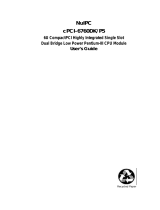
ii • Table of Contents
4.6 Channel Gain Queue Register ........................................... 24
4.7 A/D & FIFO Control Register.............................................. 25
4.8 A/D & FIFO Status Register ............................................... 27
4.9 Digital I/O register ............................................................. 28
4.10 A/D Trigger Mode Register ................................................ 29
4.11 Interrupt Control Register................................................... 31
4.12 Interrupt Status Register.................................................... 33
Chapter 5 Operation Theory...................................................34
5.1 A/D Conversion................................................................. 34
5.1.1 A/D Conversion Procedure........................................................34
5.1.2 Software conversion with polling data transfer acquisition
mode (Software Polling).............................................................35
5.1.2.1 Specifying Channels, Gains, and input
configurations in the Channel Gain Queue..........36
5.1.3 Programmable scan acquisition mode....................................36
5.1.3.1 Scan Timing and Procedure...................................36
5.1.3.2 Specifying Channels, Gains, and input
configurations in the Channel Gain Queue..........38
5.1.3.3 Trigger Modes...........................................................39
5.1.4 A/D Data Transfer Modes..........................................................47
5.2 Digital Input and Output ..................................................... 48
5.3 General Purpose Timer/Counter Operation ......................... 49
Chapter 6 Software Utility & Calibration...............................51
6.1 Running 9116util.exe program ........................................... 51
6.2 Calibration........................................................................ 52
6.2.1 What do you need.......................................................................52
6.2.2 VR Assignment............................................................................53
6.2.3 A/D Adjustment............................................................................53
6.2.3.1 PGA offset Calibration.............................................54
6.2.3.2 Bipolar input Calibration..........................................54
6.2.3.3 Unipolar input Calibration........................................54
6.3 Functional Testing............................................................. 54
Warranty Policy........................................................................56





















